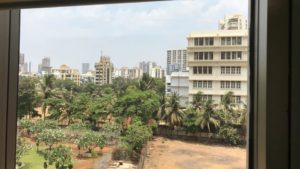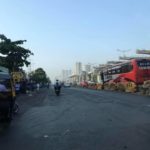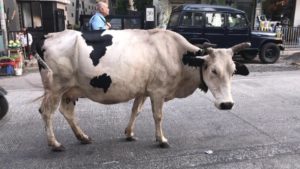Moments in Mumbai with a Pediatric Neurologist: Autumn Nidalmia ’22 at Kokilaben Dhirubhai Ambani Hospital
Apr 12, 2019The past few months have been a whirlwind of color and chaos as I have made my way through Mumbai, India for my first co-op experience. I am working at Kokilaben Dhirubhai Ambani Hospital, which is located in Andheri West. My job is an internship under Pradnya Gadgil, a pediatric neurologist.
An average day at the hospital is fairly predictable as far as structure. I arrive between 8:30 and 9:30, depending on clinic hours, and meet Pradnya in her office on the second floor. Below is the view from Pradnya’s office!

The hospital is large, with upwards of 30 floors in total. It is extremely clean by Indian standards, although in America it would certainly be regarded as less than sterile. The pediatric offices are all located in one section of the second floor, with a waiting area and reception desk to keep the patients occupied until the doctor is available.
When Pradnya arrives, our first order of business is to go on rounds; that is, to visit the inpatients which are under Pradnya’s care. There are several areas where Pradnya’s patients may be located: the PICU (Pediatric Intensive Care Unit) is generally where the highest concentration of her patients are at any given time, but there are also often patients in the NICU (Newborn Intensive Care Unit) and PCICU (Pediatric Cardiac Intensive Care Unit). The NICU is the most difficult to go to for me, as the patients have just been born as early as a couple of hours before admittance. They are so tiny, with wires sticking out of their bodies in what seems like every location possible. The check-ups usually involve discussion with the nurses who have been caring for the patients as well as with the parents to see how the child is doing. Depending on the feedback, Pradnya will adjust medication or diet as needed and the nurses will continue to monitor the patient. As epilepsy is one of the main conditions Pradnya treats, one of the main reasons the patients are in PICU is due to frequent seizures which medication has been unsuccessful in remedying thus far. By staying in the hospital, it is much easier for their reactions to be tracked and regulated until a treatment that works for them can be found. During my time here, I have seen many patients discharged.
After rounds, we return to Pradnya’s office and she begins consultations with patients. As I mentioned previously, the majority of her patients suffer from epilepsy, which is a neurological condition that causes fits or seizures to occur. It is often the result of brain damage but can also be genetic. In addition, Pradnya frequently sees patients with autism, GDD (Global Developmental Delay), ADHD, DMD (Duchenne muscular dystrophy), and CP (cerebral palsy), among other things. The consultations are much like a typical doctor’s visit in the US: the patients come in and discuss concerns with Pradnya, who subsequently asks questions and discusses treatments, as well as performs some tests of muscle use and ability when necessary.
In addition to shadowing Pradnya and learning the ins and outs of being a pediatric neurologist, I am also conducting a questionnaire with Pradnya as well as two of the psychologists at the hospital. Together, we have created a survey designed to gather data about how much the parents of children with epilepsy know about this neurological condition. The intention of the questionnaire is to figure out which misconceptions are prominent in the population and to use this information to create further resources for families in order to increase general knowledge. In India, there are many beliefs surrounding epilepsy which coincide with religion or tradition. Although some may not be harmful, many of these beliefs influence the response to a seizure, which can be very dangerous.
The questionnaire consists of 10 yes or no questions as well as some free-response questions about personal concerns or areas of confusion. It also includes a question about the best ways for the patient to receive further information. As a control group, we have also created a questionnaire for parents of patients who do not have epilepsy in order to compare the levels of knowledge. This questionnaire is the same 10 yes or no questions without the addition of the personal questions.
My main project while I am in India is conducting this questionnaire. When Pradnya finishes a consultation, I take the patient to an empty office next door and give them the questionnaire. Most of the patients speak English, but when there is a language barrier one of the nurses or secretaries (referred to as ‘sisters’ in the hospital) translates for me. At the end of the day, I enter the data into an Excel spreadsheet.
The Kokilaben, as I mentioned previously, is one of the cleaner hospitals in India. The government hospitals are much less so, and therefore far more affordable. Pradnya periodically does visits to such hospitals, seeing patients, and giving advice to the doctors (the majority of which are students) who work there. I accompanied her on one visit and was amazed by the sheer amount of people, overflowing into hallways and bustling about just outside. It looked like an army hospital, with beds in so many rows that there was hardly any space to walk between them.
These visits are certainly some of the biggest things Pradnya does to help the community outside of her own hospital, as she is very aware that the Kokilaben patients are not the only ones who need care. However, she is also generous in her own hospital, making sure no teachers or members of the armed forces ever pay for a consultation with her. Besides the more obvious benefits Pradnya’s work has on the community, these are the less noticed things that she accomplishes.
 The internship is extremely beneficial to my academic path, though it may not seem obvious at first. Although I am undecided in what exactly I will be pursuing, one of my major interests is psychology. The study of the brain, both scientifically and socially, is something I find endlessly fascinating and am always eager to learn more about. Although I have no interest in becoming a doctor, this internship has given me a chance to view not only the medical side of psychology but the social side as well. Working alongside the hospital psychologists and conducting the questionnaire, I have been given some incredibly valuable experience in psychological surveys. And perhaps if I was in America, the psychology would end there. However, being in a foreign country, psychology is absolutely everywhere, from how people treat me because of the color of my skin to how the roads operate on my drive to and from work each day.
The internship is extremely beneficial to my academic path, though it may not seem obvious at first. Although I am undecided in what exactly I will be pursuing, one of my major interests is psychology. The study of the brain, both scientifically and socially, is something I find endlessly fascinating and am always eager to learn more about. Although I have no interest in becoming a doctor, this internship has given me a chance to view not only the medical side of psychology but the social side as well. Working alongside the hospital psychologists and conducting the questionnaire, I have been given some incredibly valuable experience in psychological surveys. And perhaps if I was in America, the psychology would end there. However, being in a foreign country, psychology is absolutely everywhere, from how people treat me because of the color of my skin to how the roads operate on my drive to and from work each day.
 India is incredible, exploding with sound and color. I have been staying in an apartment building with a friend of my aunt’s who is a teacher about half an hour from the hospital. Just outside the complex, there is a busy street overflowing with life. Under the intense summer sun, people sell bananas and mangoes on the side of the road for 20 rupees; stray dogs wander by, wagging their tails if you say hello; cows cross the street unperturbed and sacred; rickshaws bustle by like great bumblebees, honking; and people walk to school, to work, to the market, swaddled in fabrics of such incredible colors you almost can’t look directly at them. Everything is dust and heat.
India is incredible, exploding with sound and color. I have been staying in an apartment building with a friend of my aunt’s who is a teacher about half an hour from the hospital. Just outside the complex, there is a busy street overflowing with life. Under the intense summer sun, people sell bananas and mangoes on the side of the road for 20 rupees; stray dogs wander by, wagging their tails if you say hello; cows cross the street unperturbed and sacred; rickshaws bustle by like great bumblebees, honking; and people walk to school, to work, to the market, swaddled in fabrics of such incredible colors you almost can’t look directly at them. Everything is dust and heat.

It’s overwhelming to be here, and I wouldn’t have it any other way. This adventure has taught me so much about the medical world, but also about the real world, and everything it can give and take.


